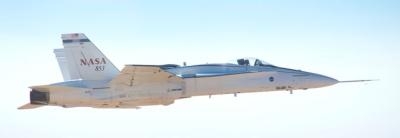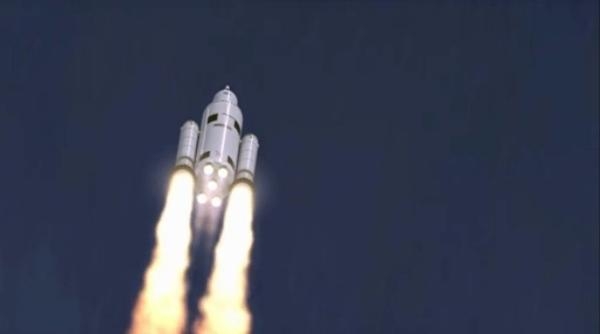Tue, Nov 26, 2013
Testing Systems That Will Guide The SLS Heavy Lift Booster On Liftoff
NASA has completed the first tests with an F/A-18 research jet to evaluate the autonomous flight control system for the agency's Space Launch System (SLS) rocket. The system, called the Adaptive Augmenting Controller, will allow SLS to respond to vehicle and environmental variations such as winds or vehicle flexibility after it blasts off the launch pad and heads toward space.

This is the first time a flight control system for a NASA rocket is being designed to adjust autonomously to unexpected conditions during actual flight rather than pre-flight predictions. This ability to make real-time adjustments to the autopilot provides enhanced performance and increased safety for the crew. The tests were flown Nov. 14-15 out of NASA's Dryden Flight Research Center at Edwards Air Force Base, CA. During the flights, more than 40 tests were conducted using SLS-like trajectories. The system was evaluated in different scenarios for up to 70 seconds at a time to match the rocket's dynamics for the majority of its flight from liftoff to solid rocket booster separation.
"By flying a high-performance F/A-18 jet in a manner similar to our rocket, we're able to simulate SLS's flight conditions and improve our software," said Tannen VanZwieten, SLS flight controls working group lead. "The innovative system that we are testing at Dryden is advancing flight control technology by adding an adaptive element which is new for launch vehicles. We're using this technology to expand the capabilities of the SLS a bit more than what is possible with a traditional design."
During the flight, NASA simulated both normal and abnormal flight conditions, such as sloshing propellant, and identified key aircraft vibrational characteristics. The flight test data will be used to refine software for SLS and plans for future F/A-18 flights, which will run through the end of the year. "This is an example of how advanced rocket technology can be checked out in flight without having to be launched into space," said John Carter, project manager for the flight tests at Dryden. "Doing this work on the F/A-18 test bed allows for low-cost, quick-schedule tests that can be repeated many times in order to gain confidence in the advanced controls technology, providing some unique testing advantages for this type of control system validation."

This flight control system will be ready for the first flight test of the SLS, scheduled for 2017. That flight will feature a 77-ton lift capacity configuration and carry an uncrewed Orion spacecraft beyond low-Earth orbit to test the performance of the integrated system. As the SLS evolves, it will provide an unprecedented lift capability of 143 tons to enable missions even farther into our solar system to places such as an asteroid and Mars.
(Pictured Top: An F/A-18 research jet simulated various flight conditions that NASA's Space Launch System may experience as it makes its way from the launch pad to space, to evaluate the rocket's flight control system. NASA / Jim Ross. Bottom: artist's rendering of SLS launch)
More News
From 2016 (YouTube Edition): The Canadian Forces Snowbirds Can Best Be Described As ‘Elegant’… EAA AirVenture 2016 was a great show and, in no small part, it was>[...]
Airplane Lunged Forward When It Was Stuck From Behind By A Tug That Was Towing An Unoccupied Airliner Analysis: At the conclusion of the air taxi flight, the flight crew were taxii>[...]
Aero Linx: International Stinson Club So you want to buy a Stinson. Well the Stinson is a GREAT value aircraft. The goal of the International Stinson Club is to preserve informatio>[...]
Request Full Route Clearance Used by pilots to request that the entire route of flight be read verbatim in an ATC clearance. Such request should be made to preclude receiving an AT>[...]
"Today's battlefield is adapting rapidly. By teaching our soldiers to understand how drones work and are built, we are giving them the skills to think creatively and apply emerging>[...]
 Classic Aero-TV: Pure Aerial Precision - The Snowbirds at AirVenture 2016
Classic Aero-TV: Pure Aerial Precision - The Snowbirds at AirVenture 2016 NTSB Final Report: Costruzioni Aeronautiche Tecna P2012 Traveller
NTSB Final Report: Costruzioni Aeronautiche Tecna P2012 Traveller ANN's Daily Aero-Linx (11.23.25)
ANN's Daily Aero-Linx (11.23.25) ANN's Daily Aero-Term (11.23.25): Request Full Route Clearance
ANN's Daily Aero-Term (11.23.25): Request Full Route Clearance Aero-News: Quote of the Day (11.23.25)
Aero-News: Quote of the Day (11.23.25)




